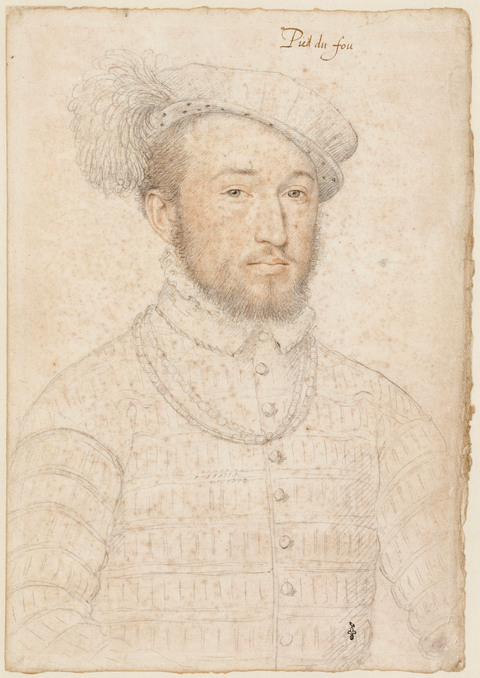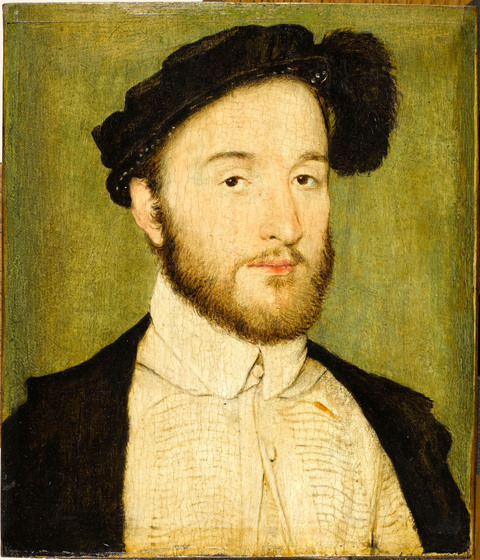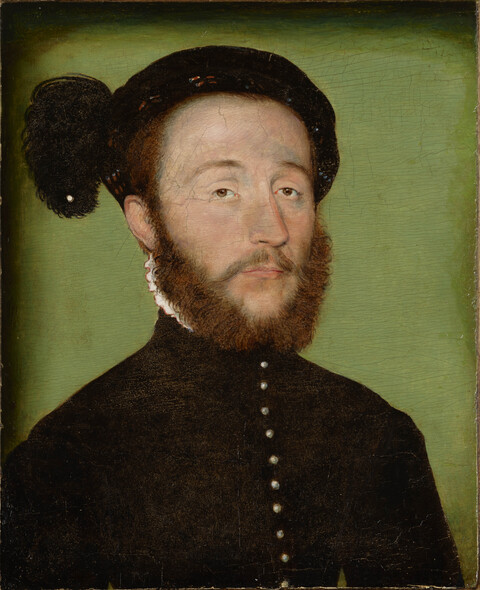Marks, Inscriptions, and Distinguishing Features
None
Entry


Author
Provenance
Walter Gay (1856–1937), Paris, by 1904.19
Possibly Jules Strauss (1861–1943), Paris.20
Germain Seligmann of (J. Seligmann et Fils, Paris and New York), by 1931, and until at least 1937.21
(Pierre F. Nesi, Beverly Hills, California) by 1947;22
G.H.A. Clowes, Indianapolis, in 1947;23
The Clowes Fund, Indianapolis, from 1958–2014, and on long-term loan to the Indianapolis Museum of Art since 1971 (C10028);
Given to the Indianapolis Museum of Art, now the Indianapolis Museum of Art at Newfields, in 2014.
Exhibitions
Musée du Louvre Paris, 1904, Les Primitifs français, no. 177 ;
The Cleveland Museum, Cleveland, 1931, Exhibition. Art through the Ages;
Exposition universelle, Brussels, 1935, Cinq siècles d’art français, no. 925 ;
Palais national, Paris, 1937, Chefs d’œuvre de l’Art Français, no. 49;
John Herron Art Museum, Indianapolis, 1959, Paintings from the Collection of George Henry Alexander Clowes: A Memorial Exhibition, no. 19;
Indiana University Art Museum, Bloomington, 1963, Northern European Painting: The Clowes Fund Collection, no. 4;
Indianapolis Museum of Art at Newfields, 2019, Life and Legacy: Portraits from the Clowes Collection.
References
Waldemar George, “L’Art français et l’esprit de suite,” La Renaissance 20, nos. 3–4 (1937), 28;
Mark Roskill, “Clowes Collection Catalogue” (unpublished typed manuscript, IMA Clowes Archive, Indianapolis Museum of Art, Indianapolis, IN, 1968);
A. Ian Fraser, A Catalogue of the Clowes Collection (Indianapolis: Indianapolis Museum of Art, 1973), 150;
Anne Dubois de Groër, Corneille de La Haye dit Corneille de Lyon (1500/1510-1575) (Paris: Arthena, 1996), no. 119, 208.
Notes
-
See André Blum, “Le costume en France au temps des Valois “1515–1590),“in Le costume des Tudor à Louis XIII, James Laver ed. (Paris: Horizons de France), 1950, 63–124, and, on sixteenth-century dress in general Jane Ashelford, A Visual History of Costume: The Sixteenth Century (London: Batsford, 1983). ↩︎
-
Henri Bouchot, ed., Les Primitifs français exposés au Pavillon de Marsan (Paris: Librarie Centrale des Beaux-Arts, 1904), no. 177, 74. ↩︎
-
Abbé Joseph Nadaud, Nobiliaire du diocèse et de la généralité de Limoges (Limoges: Vve H Ducourtieux, 1882), 1:323, and Anne Dubois de Groër, Corneille de La Haye dit Corneille de Lyon (1500/1510–1575) (Paris: Arthena, 1996), no. 119, 208. ↩︎
-
Chantilly, Musée Condé, MN 32: Alexandra Zvereva, Les Clouet de Catherine de Médicis: Chefs-d’œuvre graphiques du musée Condé, exh. cat. (Paris: Somogy éditions d’art/Chantilly: Musée Condé, Château de Chantilly, 2002), no. 70, 148. The drawing is inscribed “Pied du Fou.” ↩︎
-
Charles Sterling, Chefs-d’oeuvre de l’art français (Paris: [s.n.], 1937), no. 49, 29. ↩︎
-
Anne Dubois de Groër, Corneille de La Haye dit Corneille de Lyon (1500/1510–1575) (Paris: Arthena, 1996), 208. ↩︎
-
Louis Dimier, Histoire de la peinture de portrait en France au XVIe siècle, 3 vols. (Paris: G. van Oest et cie, 1924–1926) is an important work of reference for French Renaissance portraits but does not, however, feature the painting in question. ↩︎
-
Mark Roskill, “Clowes Collection Catalogue” (unpublished typed manuscript, IMA Clowes archive, Indianapolis Museum of Art, Indianapolis, IN, 1968). ↩︎
-
See Mark Roskill, “Clowes Collection Catalogue” (unpublished typed manuscript, IMA Clowes Archive, Indianapolis Museum of Art, Indianapolis, IN, 1968), note 4. Today the painting is in Versailles, Musée National du Château, MV 3223: Claire Constans, Les peintures: Musée National du Château de Versailles (Paris: Editions de la Réunion des musées nationaux, 1995), 2:990, no. 5547, from the Gaignières collection. The catalogue mentions two other copies (one at Vienna, Kunsthistorisches Museum, again with an inscription identifying the sitter, and one at the Château de Beauregard), as well as a drawing in the Kestner Museum, Hannover, Germany. ↩︎
-
Paris, Musée du Louvre, R.F. 1961-10. Anne Dubois de Groër, Corneille de La Haye dit Corneille de Lyon (1500/1510–1575) (Paris: Arthena, 1996), no. 116, 205–206. Two old copies are preserved in Versailles: Claire Constans, Les peintures: Musée National du Château de Versailles (Paris: Editions de la Réunion des musées nationaux, 1995), 1: no. 1002 (MV 3224); no. 1006 (MV 4068), 180. ↩︎
-
Anne Dubois de Groër, Corneille de La Haye dit Corneille de Lyon (1500/1510–1575) (Paris: Arthena, 1996), 19–21. ↩︎
-
See Philippe Bordes, “Les portraits de Corneille de Lyon: Arts de cour ou projet démocratique?” in Frédéric Elsig, ed., Peindre à Lyon au XVIe siècle (Milan: Silvana editoriale, 2014), 157. ↩︎
-
Anne Dubois de Groër, “Nouvelles recherches sur Corneille, à la lumière du Portrait de Pierre Aymeric,” Revue du Louvre 28 (1978): 36–42, especially 39 and note 34. ↩︎
-
Anne Dubois de Groër, Corneille de La Haye dit Corneille de Lyon (1500/1510–1575) (Paris: Arthena, 1996), 43–44. ↩︎
-
Sylvie Béguin, “A propos d’un nouveau Corneille,” Revue du Louvre 28 (1978): 28–35, especially 31–33. ↩︎
-
In his library, these copies were described as “Copié sur l’original peint par Corneille dans le cabinet de M. de Gaignières” (Copied after an original by Corneille in the cabinet of M. de Gaignières): see Louis Dimier, Histoire de la peinture de portrait en France au XVIe siècle, 3 vols. (Paris: G. van Oest et cie, 1924–1926), 2:58, who cites Henri Bouchot, Les Clouet et Corneille de Lyon (Paris: Librairie de l'art, 1892), 35. ↩︎
-
Stamps and labels on the back of the lining canvas most likely date from the early twentieth century; for a detailed description, see the Technical Examination Report. ↩︎
-
For a detailed condition report, see the Technical Examination Report. ↩︎
-
The American painter Walter Gay, residing in France, loaned the painting to Exposition des Primitifs Français, exh. cat. (Paris: Palais du Louvre and Bibliothèque Nationale, 1904), no. 177. The painting is included in Anne Dubois de Groër, Corneille de La Haye dit Corneille de Lyon (Paris: Arthena, 1996), no. 119. ↩︎
-
Both Seligmann and Nesi list Jules Strauss, a major collector of Impressionism, as a former owner. Although inconclusive, correspondence with Strauss’s grandson revealed that the painting is not listed in Jules Strauss’s notebooks in his possession, see Michel Strauss, email message to Annette Schlagenhauff, 9 December 2010, Provenance files, Indianapolis Museum of Art at Newfields. ↩︎
-
The painting was loaned by Seligmann to an exhibition Art through the Ages at the Cleveland Museum of Art in fall 1931. Although there was no catalogue for this exhibition, files in the Registration Department at the Cleveland Museum of Art confirm its inclusion in this exhibition; Matthew Gengler, Librarian, e-mail message to Annette Schlagenhauff, 2 December 2010, Provenance files, Indianapolis Museum of Art at Newfields. The painting was also loaned to a 1937 Paris exhibition, see Chefs d’oeuvres de l’art français, exh. cat. (Paris: Palais des arts, Paris, 1937,) no. 49. ↩︎
-
The painting is documented as being sold by Seligmann to Nesi in Folder “G.H.A. Clewes [sic],” Box 180, Jacques Seligmann & Co. Records, Archives of American Art, Washington, D.C.; see copy in Provenance file, Indianapolis Museum of Art at Newfields. Germain Seligmann noted that he visited both Walter Gay and Jules Strauss, the two successive early owners, quite often in Paris; see Letter from Seligmann to Nesi, 10 June 1947, File C10028, IMA Clowes Registration Archive, Indianapolis Museum of Art at Newfields. ↩︎
-
Bill of sale from Nesi to Clowes, 26 July 1947, in File C10028, Clowes Registration Archive, Indianapolis Museum of Art at Newfields. ↩︎
